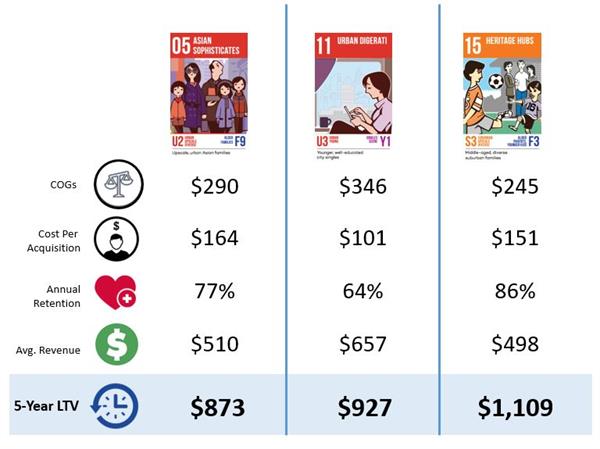Taking Lifetime Value to a New Level
Marketers can be myopic.
All too often, they focus on acquiring as many customers as possible over the short term, rather than taking the time to step back and analyze the consequences of that objective on the future of their business. To avoid this problem, some marketers employ analysis techniques that can help them understand the long-term value of their customers. The most common of these techniques is developing a customer lifetime value (LTV) score – which determines the worth of customers based on their future value as opposed to their immediate profitability. While this approach can deliver some valuable customer insight, it can be limited. Its results can fail to deliver a full view of what is happening within a customer segment and what action or next step a marketer should take to realize the highest LTV from their best customers.
By layering a geodemographic segmentation system like PRIZM5 into a traditional LTV analysis, marketers can gain further understanding into what the scores mean, and what actions to take regarding product development or media optimization. Better yet, a business can use PRIZM5 to find more customers that are similar to those with the highest scores. To illustrate this, I put a typical LTV analysis of the hypothetical no-frills gym Guido’s Fitness through the ringer.
First, let’s start by walking through the elements of the calculation. Depending on the industry and type of business, these may vary slightly, but they tend to include a few core concepts:
- Average cost per acquisition – This value is typically the cost of the campaign or discount used to acquire a customer. It usually includes any channel costs as well.
- Average cost of goods sold (COGS) – Including the cost of the products purchased by a customer is especially important for businesses with a broad assortment of products with varying margins.
- Average revenue per customer – This is the average income a business earns from a customer during the period of analysis, typically one year or one month -depending on the industry.
- Retention/repurchase rate – This value will differ significantly depending on the industry or department of a business. For instance, a finance or insurance company may use a retention rate as a key metric since their customers tend to be longer term and often have annualized contracts. However, for a retailer, a repurchase rate might make more sense since retail customers spend at less predictable intervals. Essentially, analysts need to determine what proportion of customers are sticking around or coming back for more.
COHORT ANAYSIS
Using those four elements, we’ll analyze the LTV of Guido’s Fitness customers over a two-month period. And to make the analysis more effective, we will perform a cohort analysis, which groups customers based on period of acquisition, product purchased or any other available dimension. Comparing the LTV of these cohorts can give marketers insights into which marketing initiatives are bringing in higher value customers. For instance, if customers acquired in the month of May 2015 display a higher LTV than customers acquired in June 2015, we might conclude that the marketing campaigns or promotions run in May attracted a better type of customer than those in June and, as such, should be run again the following year. Take a look at the calculations below.
LTV of Guido's Fitness Customers*
| Acquired May 2015 | Acquired June 2015 | |
| Cost per Acquisition: | $139 | $120 |
| COGS: | $294 | $312 |
| Annual Retention: | 76% | 80% |
| Average Annual Revenue: /td> | $520 | $475 |
| 5-Year LTV: | $895 | $868 |
*Calculations assume an annual discount rate of 10% which is used to incorporate the time value of money and inflation.
There is clearly some difference between customers acquired during these two months, but depending on our access to additional data, we may not be certain why these differences exist. What is it that made the LTV of people acquired in May more valuable—and how can I find more of them? EA’s PRIZM5 segmentation system with its 68 lifestyle types can help answer these questions. If we broke out our LTV analysis by PRIZM5 segment—as opposed to month of acquisition—we may be able to elevate this analysis to a new level. The graphic below displays the LTV of three customer lifestyle types for Guido’s Fitness.
SEGMENTATION ANALYSIS
 In this example, each of the PRIZM5 segments have very different purchase behaviours. Without even getting into the LTV scores, we can identify differences between the groups that can help Guido market his gym smarter. The members of segment 11-Urban Digerati (younger, well-educated city singles) are spending the most per year, but their retention rate is also the lowest, at 64 percent. On the other hand, members in segment 15-Heritage Hubs (middle-aged, diverse suburban families) offer the highest retention rate, but the lowest spend. Considering the lifestyles of these two segments, we can infer that a younger urban group seems to be more likely to purchase additional gym services, such as workshops and personal training, creating higher revenue for Guido; this pattern also explains the higher cost of goods sold.
In this example, each of the PRIZM5 segments have very different purchase behaviours. Without even getting into the LTV scores, we can identify differences between the groups that can help Guido market his gym smarter. The members of segment 11-Urban Digerati (younger, well-educated city singles) are spending the most per year, but their retention rate is also the lowest, at 64 percent. On the other hand, members in segment 15-Heritage Hubs (middle-aged, diverse suburban families) offer the highest retention rate, but the lowest spend. Considering the lifestyles of these two segments, we can infer that a younger urban group seems to be more likely to purchase additional gym services, such as workshops and personal training, creating higher revenue for Guido; this pattern also explains the higher cost of goods sold.
But which segment is more valuable to Guido? The cost to acquire members from each segment also differs, which likely has to do with the type of media and purchase channels preferred by each segment. Those in 11-Urban Digerati, have a preference for less expensive online channels like social media while members of 15-Heritage Hubs and 05-Asian Sophisticates (upscale, urban Asian families) are more responsive to costlier delivered flyer and email offers.
Once we calculate the five-year LTV score we see that 15-Heritage Hubs members offer the highest value, at $1,109. We can conclude that 15-Heritage Hubs is home to more valuable customers over time than the other two segments, and therefore Guido’s Fitness should be focusing its budget on acquiring them. But our analysis shouldn’t end there. PRIZM5-linked data can help inform the right approach to take with each customer type depending on their LTV score.
Using EA’s Social Values database, we can learn more about the psychographics of these groups. Members of Urban Digerati are health conscious and concerned with their personal appearance, so it makes sense that they would be willing to literally go that extra mile at the gym and spend more on ancillary services. Those in Heritage Hubs are also health conscious, but since they are families with young children, they typically face huge constraints on their time and money. This being said, Heritage Hubs consumers are also loyal to brands that they have a great experience with, and they’re less concerned with shopping around for a new gym. Meanwhile, Urban Digerati members are more likely to switch to a newer, nicer looking gym getting a lot of buzz on social media.
The bottom line is that there is no perfect target for Guido’s Fitness. LTV is a useful tool in understanding a customer’s value but this should not be the end of the story. Pairing LTV with additional consumer insights can allow marketers to determine different strategies and tactics for customers with differing value levels. For instance, Guido’s Fitness can concentrate the bulk of its marketing efforts on prospects from the valuable Heritage Hubs segment, but also reserve a certain portion of its budget for digital marketing targeted at those in the Urban Digerati segment. And as with all data-driven marketing campaigns, Guido should establish success metrics and track results to help determine whether his more targeted approach achieved meaningful results.
Marketers may be myopic, but as Guido learned, there is a remedy. By combining traditional business analysis techniques with state-of-the-art segmentation tools and data products from Environics Analytics, any business can help elevate its understanding of its customers.
###
 Vito De Filippis brings a background in relationship marketing, sales and analytics to his role as Director of Consulting Services with EA’s finance, insurance, travel and tourism practice.
Vito De Filippis brings a background in relationship marketing, sales and analytics to his role as Director of Consulting Services with EA’s finance, insurance, travel and tourism practice.


